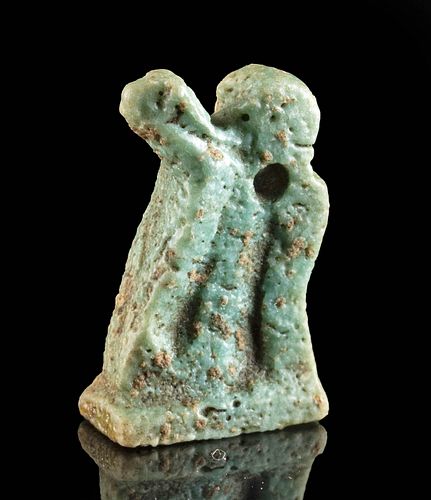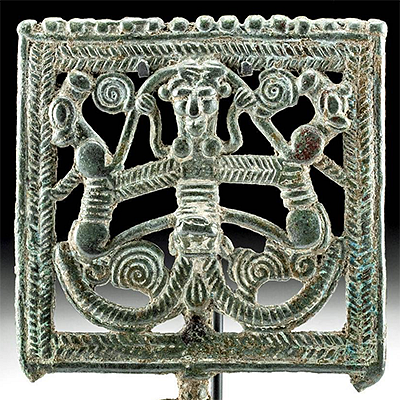Egyptian Faience Amulet - Uraeus
Lot 5b
About Seller
Artemis Fine Arts
686 S Taylor Ave, Ste 106
Louisville, CO 80027
United States
Selling antiquities, ancient and ethnographic art online since 1993, Artemis Gallery specializes in Classical Antiquities (Egyptian, Greek, Roman, Near Eastern), Asian, Pre-Columbian, African / Tribal / Oceanographic art. Our extensive inventory includes pottery, stone, metal, wood, glass and textil...Read more
Categories
Estimate:
$400 - $600
Absentee vs Live bid
Two ways to bid:
- Leave a max absentee bid and the platform will bid on your behalf up to your maximum bid during the live auction.
- Bid live during the auction and your bids will be submitted real-time to the auctioneer.
Bid Increments
| Price | Bid Increment |
|---|---|
| $0 | $25 |
| $300 | $50 |
| $1,000 | $100 |
| $2,000 | $250 |
| $5,000 | $500 |
| $10,000 | $1,000 |
| $20,000 | $2,500 |
| $50,000 | $5,000 |
| $100,000 | $10,000 |
| $200,000 | $20,000 |
About Auction
By Artemis Fine Arts
Nov 5, 2020
Set Reminder
2020-11-05 10:00:00
2020-11-05 10:00:00
America/New_York
Bidsquare
Bidsquare : Ancient & Ethnographic From Around the World
https://www.bidsquare.com/auctions/artemis-gallery/ancient-ethnographic-from-around-the-world-5916
Ancient art from Egypt, Greece, Italy and the Near East, as well as Asian, Pre-Columbian, Native American, African / Tribal / Oceanic, Spanish Colonial, Russian Icons, Fine art, much more! All categories, all price ranges... all legally acquired and guaranteed to be as described or your money back. Artemis Fine Arts info@artemisfinearts.com
Ancient art from Egypt, Greece, Italy and the Near East, as well as Asian, Pre-Columbian, Native American, African / Tribal / Oceanic, Spanish Colonial, Russian Icons, Fine art, much more! All categories, all price ranges... all legally acquired and guaranteed to be as described or your money back. Artemis Fine Arts info@artemisfinearts.com
- Lot Description
Egypt, Late Dynastic to Hellenistic, Dynasties 26 to 31, ca. 664 to 30 BCE. A lovely wearable faience amulet molded in the form of a snake or cobra with its body folded twice and its head facing up on a rectangular integral plinth. A small hole is horizontally drilled at the top of the snake's body, so the pendant can be suspended and worn. A symbol of royalty and resurrection, the coiled up cobra, or uraeus, as amulet was intended to provide the non-royal deceased with the protection usually reserved for royalty. Also embellished with glaze of a seafoam green hue, this piece is a wonderful example form ancient Egypt. Size: 0.5" W x 0.75" H (1.3 cm x 1.9 cm)
From the earliest dynasties the upreared cobra, the uraeus, was the emblem of royalty and worn on a pharaoh's forehead to signify his kingship and divinity. As a goddess she was the eye of the sun, spitting fire at the king's enemies. The uraeus was among the amulets depicted in both the MacGregor papyrus and the Osiris complex at Dendera. Usually more than one was placed on the mummy, sometimes at the forehead or even over the feet, but most often on the torso. The uraeus exists in two basic forms from the twenty-sixth dynasty onwards. In both the fully puffed-up hood is carefully detailed; in the commoner type a great coil of the body arches up behind to the same height as the head (as is the case on our amulet) and has a suspension loop on top of it. In the other form only the tip of the tail appears to one side of the base of the hood which lies against a back pillar pierced for suspension. See Carol Andrews, Amulets of Ancient Egypt (London, British Museum Press, 1994), p. 34-35 and especially p. 75-76 and fig. 76b.
Snakes are some of the most ancient animals noted in artwork from ancient Egypt and have garnered both reverence and fear throughout the millennia. According to scholar Dorothea Arnold, "Cobras, the best known of Egypt's many snakes, are also among the most impressive. Their raised threat posture and the way some of the species spit venom are thoroughly intimidating. The ancient Egyptians were so fascinated by these behaviors that they adopted the cobra as a mythical snake. The uraeus, as it was called in Greek, sat on the foreheads of pharaohs and guarded the rooves of holy shrines with awe-inspiring aggressiveness." (Arnold, Dorothea. "An Egyptian Bestiary." The Metropolitan Museum of Art Bulletin, Spring 1995, Vol. LII, no. 4, p. 43).
Though some snakes like uraei cobras were perceived as signs of pharaonic power, royalty, and control over magical forces, not all were viewed with such affection; the most fervently detested, however, was the titanic serpent-form god Apophis (also Apep). Author Peter Clayton writes how Apophis was, "In Egyptian mythology a gigantic serpent whose nature symbolized the idea of chaos and non-existence which all Egyptians dreaded. When Re the sun god descended behind Bakhu, the mountain of the west, to travel the twelve hours of night through the Underworld, Apophis lay in wait in order to swallow him. The sun god was towed along the Underworld waters on a boat but his crew became hypnotized by the stare of Apophis. The rescuer of Re was the god Seth whose strength matched that of Apophis who was subdued by a magical chant." (Clayton, Peter. "Great Figures of Mythology." Crescent Books, New York/New Jersey, 1994, p. 34)
Provenance: ex Estate of Eldert Bontekoe, Pegasi Numismatics, Ann Arbor, Michigan, USA, acquired before 2000
All items legal to buy/sell under U.S. Statute covering cultural patrimony Code 2600, CHAPTER 14, and are guaranteed to be as described or your money back.
A Certificate of Authenticity will accompany all winning bids.
We ship worldwide and handle all shipping in-house for your convenience.
#158965Expected nicks and chips to surface commensurate with age. Otherwise, intact and wearable with nice earthen deposits in recessed areas.Condition
- Shipping Info
-
All shipping is handled in-house for your convenience. Your invoice from Artemis Gallery will include shipping calculation instructions. If in doubt, please inquire BEFORE bidding for estimated shipping costs for individual items.
-
- Buyer's Premium



 EUR
EUR CAD
CAD AUD
AUD GBP
GBP MXN
MXN HKD
HKD CNY
CNY MYR
MYR SEK
SEK SGD
SGD CHF
CHF THB
THB














